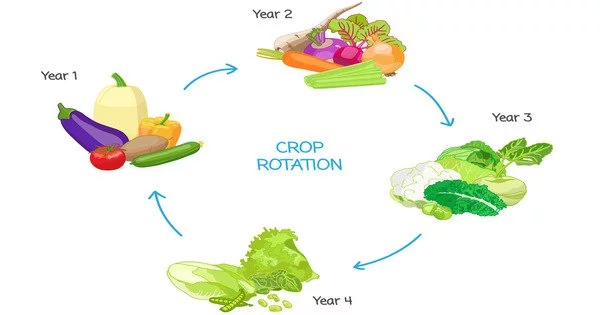Crop rotation is a fundamental agricultural practice that entails the systematic planting of different crops in the same region, with each crop cultivated progressively over a specific time period. It is the technique of producing a variety of crops in the same place over the course of several growing seasons. This approach decreases crops’ dependency on a single set of nutrients, insect and weed pressure, and the likelihood of generating resistant pests and weeds. This method is intended to increase soil fertility, reduce pests and diseases, and increase crop output.
Monocropping, or growing the same crop in the same location for several years in a row, gradually depletes the soil of certain nutrients and selects for a highly competitive insect and weed community. Monoculture production is heavily dependent on external inputs that may be damaging to soil fertility unless nutrient consumption is balanced and pest and weed communities are diversified. A well-designed crop rotation, on the other hand, can reduce the demand for synthetic fertilizers and pesticides by better utilizing ecosystem services from a diversified range of crops. Crop rotations can also improve soil structure and organic matter, reducing erosion and increasing farm system resilience.
There are several key benefits associated with crop rotation:
- Soil fertility management: The nutritional requirements of various crops differ. Farmers can prevent soil depletion of specific nutrients by alternating crops. Leguminous plants, for example, fix nitrogen in the soil, which benefits following crops that require nitrogen.
- Pest and disease control: It can aid with natural pest and disease control. Pests unique to various crops are less likely to build up in the soil when crops are rotated, minimizing the need for chemical interventions.
- Weed control: Different crops have varied root structures and development tendencies, which can aid in weed suppression naturally. Crop rotation can successfully disrupt weed growth cycles, lowering weed pressure in an area.
- Improved soil structure: Different crops have varying root structures, which can help improve soil structure by breaking up compacted soil and promoting aeration. This, in turn, enhances water infiltration and retention.
- Diversification of income: Rotating different crops can diversify a farmer’s income stream. This can help reduce the risks associated with relying on a single crop, as each crop may have different market demand and price fluctuations.
Simple two-year rotations (such as corn and soybeans), three-year rotations (such as corn, soybeans, and wheat), and more sophisticated systems including multiple crops over a longer time frame are all common crop rotation systems.
Crop rotation is an important component of sustainable agriculture since it supports environmental conservation while also assisting in the maintenance of long-term agricultural productivity. Farmers can achieve more sustainable and resilient agricultural methods by using a balanced approach to crop selection and rotation.
















